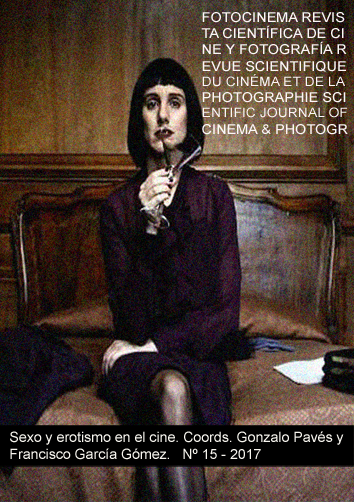¿Un Ozu pornográfico? Hentai Kazoku: el experimento venéreo de Suo Masayuki
DOI:
https://doi.org/10.24310/Fotocinema.2017.v0i15.3514Keywords:
erotismo, pornografía, Pinku Eiga, Roman poruno, Suo Masayuki, Yasujiro Ozu, Eroticism, PornographyAbstract
El primer largometraje que realizara el cineasta japonés Suo Masayuki en 1983, Hentai kazoku : Aniki no o yome-san (Una familia anormal: La mujer de mi hermano mayor) plantea una combinación aparentemente imposible: se trata de una atrevida parodia de las historias familiares de Yasujiro Ozu, pero realizada bajo las convenciones del cine pornográfico. El resultado es insólito y transgresor: una evocación del cine de Ozu, rodado con su austero estilo característico, y con unos protagonistas que evocan los personajes interpretados por Setsuko Hara y Chishu Ryu, pero filmados bajo claves eróticas. Una parodia, al fin y al cabo, tan insólita como explosiva. El propósito de este experimento cinematográfico, que aúna mímesis e ironía, no se ve motivado tanto por el gesto iconoclasta, cuanto por el deseo de rendir un desenfadado homenaje al maestro por el que se siente veneración. El presente trabajo analiza los pormenores de tan singular película, reconociendo en ella las huellas del director de Cuentos de Tokio, al tiempo que se identifican en sus escenas los límites y las convenciones del roman poruno.
Abstract:
The first feature film directed in 1983 by the Japanese Filmmaker Suo Masayuki, Hentai kazoku : Aniki no o yome-san (Abnormal family: Older Brother’s Bride) departs from an apparently impossible mix: a daring parody of Yasujiro Ozu´s classical family films, but shot under the conventions of the pornographic cinema. The result is unusual and shaking: an evocation of Ozu´s creative world, shot with his characteristic severe style and with his recurrent characters performed by Setsuko Hara and Chishu Ryu, but translated into an erotic tale. Conceived as an explosive and irreverent parody, this experimental film links mimesis with irony. Its final target is not only the iconoclastic purpose, but the breezy homage paid to the revered master. This work analyzes such an uncommon film, trying to recognize along its images the traces of Ozu, as well as the limits and conventions of the roman poruno.
Downloads
Metrics
Publication Facts
Reviewer profiles N/A
Author statements
Indexed in
-
—
- Academic society
- N/A
- Publisher
- Universidad de Málaga
References
Arqués, R. (1979). “Del erotismo : Una definición”. Camp de l´Arpa, Junio, nº 64, p. 5.
Bordwell, D. (1988). Ozu and the Poetics of Cinema. New Jersey: Princeton University Press.
Bresson, r. (1997). Notas sobre el cinematógrafo. Madrid: Árdora.
Ehrlich, L. (1998 a). “Dancing for the fun of it: Conversation with Suô Masayuki”. Japan Quarterly, January - March, p. 22.
Ehrlich, L. (1998 b). “Shall we dance?”. Asian cinema, Spring, pp. 96 - 97.
Freixas, R. & bassa, J. (2000). El sexo en el cine y el cine de sexo. Barcelona: Paidós.
Hasumi, S. (1998). Yasujiro Ozu. Paris: Cahiers du Cinéma.
Ishagpour, Y. (1994). Formes de l´impermanence: Le style de Yasujiro Ozu: Où l´on va au Japon pour revenir dans l´Occident de la présumée fin de l´Histoire. Bruselas: Yellow Now.
Lawrence, D.H. (1979). “Pornografía y obscenidad”. Camp de l´Arpa, Junio, nº 64, pp. 7 - 11.
Miret, R. (1981). “Yasujiro Ozu: Primavera perenne de un cineasta intemporal”. Dirigido por..., nº 81, pp. 25-36 (primera parte).
Miret, R. (1981). “Yasujiro Ozu: Primavera perenne de un cineasta intemporal”. Dirigido por..., nº 82, pp. 26-39 (segunda parte).
Oshima, N. (1992). Cinema, Censorship and the State: The Writings of Nagisa Oshima: 1956 - 1978. Cambridge (Massachusetts); London: The MIT Press.
Rayns, T. (1995). “Japan: Sex and Beyond”. Sight and Sound, June, v. 5, nº 6, pp. 26-29.
Richie, D. (1974). Ozu. Berkeley: University of California Press.
Santos, A. (2010). En torno a Noriko: Primavera tardía, Principios de verano, Cuentos de Tokio. Valencia: Filmoteca; Instituto Valenciano de Cinematografía Ricardo Muñoz Suay.
Santos, A. (2012). Yasujiro Ozu: Elogio del silencio. Madrid: Cátedra.
Santos, A. (2014). Ozu: Tiempo de cine: Yasujiro Ozu en los tiempos de estruendo. Tomo I: El Todo y la Nada. Tokyo: Texnai.
Sontag, S. (1979). “La imaginación pornográfica”. Camp de l´Arpa, Junio, nº 64, pp. 21 - 24.
Trías, E. (1979). “El Amor y la Muerte”. Camp de l´Arpa, Junio, nº 64, p. 35.
Yasujiro O. (1979). Valladolid: 24 Semana Internacional de Cine.
Yoshida, K. (2003). Ozu´s Anti-Cinema. Ann Arbor: Center for Japanese Studies, University of Michigan.
Downloads
Published
How to Cite
Issue
Section
License
All contents published in Fotocinema Revista científica de cine y fotografía are protected under the Creative Commons Attribution-NonCommercial-ShareAlike 4.0 International (CC BY-NC-SA 4.0) license. All about this license is available in the following link: <http://creativecommons.org/licenses/by-nc-sa/4.0>
Users can copy, use, redistribute, share and exhibit publicly as long as:
- The original source and authorship of the material are cited (Journal, Publisher and URL of the work).
- It is not used for comercial purposes.
- The existence of the license and its especifications are mentioned.
There are two sets of authors’ rights: moral and property rights. Moral rights are perpetual prerogatives, unrenounceable, not-transferable, unalienable, imprescriptible and inembargable. According to authors’ rights legislation, Fotocinema. Revista científica de cine y fotografía recognizes and respects authors moral rights, as well as the ownership of property rights, which will be transferred to University of Malaga in open access. The property rights are referred to the benefits that are gained by the use or the dissemination of works. Fotocinema. Revista científica de cine y fotografía is published in an open access form and it is exclusively licenced by any means for doing or authorising distribution, dissemination, reproduction, , adaptation, translation or arrangement of works.
Authors are responsable for obtaining the necessary permission to use copyrighted images.














13.png)



